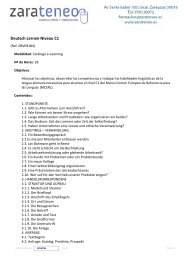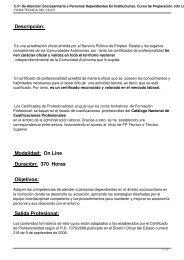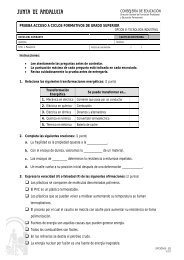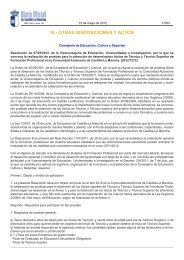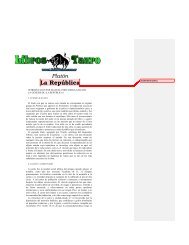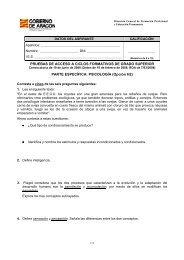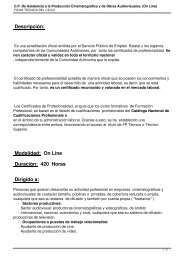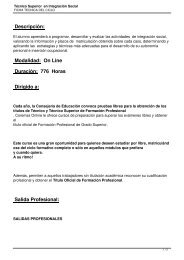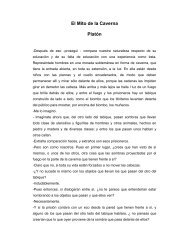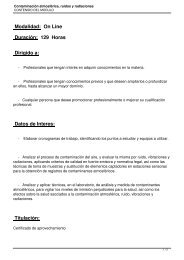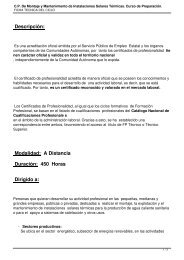Enlace Ejercicios de ECONOMÃA, GEOGRAFÃA, 2ª LENGUA ...
Enlace Ejercicios de ECONOMÃA, GEOGRAFÃA, 2ª LENGUA ...
Enlace Ejercicios de ECONOMÃA, GEOGRAFÃA, 2ª LENGUA ...
You also want an ePaper? Increase the reach of your titles
YUMPU automatically turns print PDFs into web optimized ePapers that Google loves.
CONSEJERÍA DE EDUCACIÓN<br />
Dirección General <strong>de</strong> Formación Profesional<br />
y Educación Permanente<br />
PRUEBA ACCESO A CICLOS FORMATIVOS DE GRADO SUPERIOR<br />
OPCIÓN A: ECONOMÍA<br />
DATOS DEL ASPIRANTE<br />
Apellidos:<br />
CALIFICACIÓN PRUEBA<br />
Nombre:<br />
D.N.I. o Pasaporte: Fecha <strong>de</strong> nacimiento: / /<br />
Instrucciones:<br />
<br />
<br />
<br />
Lee atentamente las preguntas antes <strong>de</strong> contestar.<br />
La puntuación máxima <strong>de</strong> cada pregunta está indicada en cada enunciado.<br />
Revisa cuidadosamente la prueba antes <strong>de</strong> entregarla.<br />
1.- Completa los huecos que faltan en las siguientes frases utilizando las palabras que aparecen a<br />
continuación, cada palabra es para rellenar un solo hueco, no pudiéndose repetir. (1 puntos)<br />
privada<br />
pymes<br />
multinacionales<br />
individual<br />
transformadoras<br />
acciones<br />
<br />
<br />
<br />
<br />
<br />
<br />
El sector secundario compren<strong>de</strong> las empresas que realizan activida<strong>de</strong>s __________________ o industriales.<br />
Según la propiedad <strong>de</strong>l capital, la empresa ____________________ es propiedad <strong>de</strong> personas<br />
físicas o jurídicas particulares.<br />
Si tenemos en cuenta la clasificación <strong>de</strong> las empresas según su forma jurídica, estas se divi<strong>de</strong>n en dos,<br />
en empresa <strong>de</strong> socios o sociedad y empresa ____________________.<br />
Las empresas ____________________son las que no sólo están establecidas en sus países <strong>de</strong><br />
origen, sino que también se constituyen en otros países.<br />
Las ____________________ representan el 90% <strong>de</strong>l total <strong>de</strong> las empresas españolas.<br />
En las socieda<strong>de</strong>s anónimas el capital mínimo <strong>de</strong> constitución es <strong>de</strong> 60101,21 € y el capital está<br />
dividido en ____________________.<br />
2.- La empresa Flores S.L., empresa <strong>de</strong>dicada a la comercialización <strong>de</strong> material <strong>de</strong> jardinería,<br />
presenta los siguientes elementos patrimoniales (en euros): (2 puntos)<br />
Reservas estatutarias: 20.000<br />
Elementos <strong>de</strong> transporte: 140.000<br />
Proveedores: 16.000<br />
Maquinaria: 62.000<br />
Terrenos y bienes naturales: 20.000<br />
<br />
Capital social: a <strong>de</strong>terminar<br />
Caja: 4.000<br />
Clientes: 20.000<br />
<br />
Préstamos a L/P con entida<strong>de</strong>s <strong>de</strong><br />
crédito: 64.000<br />
Mobiliario: 30.000<br />
<br />
Proveedores <strong>de</strong> inmovilizado a L/P:<br />
12.000<br />
Merca<strong>de</strong>rías: 8.000<br />
Banco: 8.000
CONSEJERÍA DE EDUCACIÓN<br />
Dirección General <strong>de</strong> Formación Profesional<br />
y Educación Permanente<br />
PRUEBA ACCESO A CICLOS FORMATIVOS DE GRADO SUPERIOR<br />
OPCIÓN A: ECONOMÍA<br />
DATOS DEL ASPIRANTE<br />
Apellidos:<br />
CALIFICACIÓN PRUEBA<br />
Nombre:<br />
D.N.I. o Pasaporte: Fecha <strong>de</strong> nacimiento: / /<br />
A. Completa el siguiente Balance <strong>de</strong> Situación, colocando cada elemento patrimonial en su masa<br />
correspondiente (1,5 puntos).<br />
B. En la misma tabla, calcula el importe <strong>de</strong>l capital social (0,5 puntos).<br />
BALANCE DE SITUACIÓN<br />
ACTIVO<br />
PATRIMONIO NETO Y PASIVO<br />
A)ACTIVO NO<br />
252.000 A)PATRIMONIO NETO O<br />
200.000<br />
CORRIENTE<br />
RECURSOS PROPIOS<br />
252.000 -<br />
INMOVILIZADO<br />
- -<br />
- B) PASIVO NO CORRIENTE 76.000<br />
- -<br />
-<br />
B) ACTIVO CORRIENTE 40.000<br />
C) PASIVO CORRIENTE<br />
8.000 -<br />
EXISTENCIA<br />
-<br />
16.000<br />
REALIZABLE<br />
-<br />
DISPONIBLE<br />
-<br />
20.000<br />
12.000<br />
-<br />
TOTAL ACTIVO<br />
292.000 TOTAL PATRIMONIO NETO Y<br />
PASIVO<br />
292.000
CONSEJERÍA DE EDUCACIÓN<br />
Dirección General <strong>de</strong> Formación Profesional<br />
y Educación Permanente<br />
3.- Lee atentamente las siguientes preguntas y señale la respuesta correcta. (2 puntos).<br />
A. ¿Cuál <strong>de</strong> las siguientes alternativas tiene un coste <strong>de</strong> oportunidad nulo?:<br />
Comprar un vi<strong>de</strong>ojuego.<br />
Comprarse un helado.<br />
Ninguna <strong>de</strong> las anteriores.<br />
B. Las empresas, como agentes económicos, toman <strong>de</strong>cisiones:<br />
Sobre qué bienes y servicios se van a consumir.<br />
Sobre la producción y la distribución <strong>de</strong> bienes y servicios.<br />
Sobre cómo ayudar a los países menos <strong>de</strong>sarrollados.<br />
C. Los elementos básicos empleados en la producción <strong>de</strong> bienes y servicios se <strong>de</strong>nominan:<br />
Agentes económicos.<br />
Recursos naturales.<br />
Factores <strong>de</strong> producción.<br />
D. En los sistemas <strong>de</strong> planificación central:<br />
El Estado planifica la actividad económica.<br />
Los individuos participan en la toma <strong>de</strong> <strong>de</strong>cisiones.<br />
El marco político es la <strong>de</strong>mocracia.<br />
4.- El objetivo principal <strong>de</strong> las empresas es maximizar beneficios, aunque el obtener un beneficio<br />
positivo, <strong>de</strong>pen<strong>de</strong>rá <strong>de</strong> los costes e ingresos que tenga la empresa en un momento<br />
<strong>de</strong>terminado <strong>de</strong>l tiempo. Las empresas para conseguir ven<strong>de</strong>r sus productos realizan una serie<br />
<strong>de</strong> estrategias <strong>de</strong> marketing a corto y largo plazo.<br />
En esta pregunta lo que tienes que hacer es contestar a lo que se te pregunta teniendo en<br />
cuenta que tú vas a abrir un negocio, exactamente vas a comenzar con una pana<strong>de</strong>ría.<br />
(3 puntos)<br />
A. ¿A qué serie <strong>de</strong> costes te estas enfrentando a la hora <strong>de</strong> comenzar tu negocio? (0,5 puntos)<br />
.............................................................................................................................................................<br />
.............................................................................................................................................................<br />
.............................................................................................................................................................<br />
.............................................................................................................................................................<br />
.............................................................................................................................................................<br />
B. En el enunciado se comenta que las empresas para conseguir ven<strong>de</strong>r sus productos realizan una serie<br />
<strong>de</strong> estrategias <strong>de</strong> marketing. ¿Cuáles son las cuatro variables <strong>de</strong>l marketing-mix? (1 punto)<br />
............................................................................................................................................................................<br />
............................................................................................................................................................................<br />
............................................................................................................................................................................
CONSEJERÍA DE EDUCACIÓN<br />
Dirección General <strong>de</strong> Formación Profesional<br />
y Educación Permanente<br />
............................................................................................................................................................................<br />
............................................................................................................................................................................<br />
............................................................................................................................................................................<br />
C. Como acabas <strong>de</strong> abrir una pana<strong>de</strong>ría, podrías llevar a cabo algunas estrategias <strong>de</strong> marketing. Pon dos<br />
ejemplos <strong>de</strong> cómo podrías utilizarlas en tu negocio. (0,5 puntos)<br />
.............................................................................................................................................................<br />
.............................................................................................................................................................<br />
.............................................................................................................................................................<br />
.............................................................................................................................................................<br />
.............................................................................................................................................................<br />
D. Se ha comentado también que el principal objetivo <strong>de</strong> las empresas es maximizar beneficio. Indica<br />
cómo se calcula el beneficio <strong>de</strong> una empresa, explicando brevemente cada componente <strong>de</strong> la<br />
fórmula. (0,5 puntos)<br />
.............................................................................................................................................................<br />
.............................................................................................................................................................<br />
.............................................................................................................................................................<br />
.............................................................................................................................................................<br />
.............................................................................................................................................................<br />
.............................................................................................................................................................<br />
.............................................................................................................................................................
CONSEJERÍA DE EDUCACIÓN<br />
Dirección General <strong>de</strong> Formación Profesional<br />
y Educación Permanente<br />
PRUEBA ACCESO A CICLOS FORMATIVOS DE GRADO SUPERIOR<br />
OPCIÓN A: GEOGRAFÍA<br />
DATOS DEL ASPIRANTE<br />
Apellidos:<br />
CALIFICACIÓN PRUEBA<br />
Nombre:<br />
D.N.I. o Pasaporte: Fecha <strong>de</strong> nacimiento: / /<br />
Instrucciones:<br />
<br />
<br />
<br />
Lee atentamente las preguntas antes <strong>de</strong> contestar.<br />
La puntuación máxima <strong>de</strong> cada pregunta está indicada en cada enunciado.<br />
Revisa cuidadosamente la prueba antes <strong>de</strong> entregarla.<br />
1.- Este gráfico representa un perfil topográfico <strong>de</strong> la península Ibérica, <strong>de</strong>s<strong>de</strong> Gijón, en el mar<br />
Cantábrico hasta Almería, en el mar Mediterráneo. Analízalo y contesta a las preguntas<br />
siguientes. (2 puntos)<br />
A. Enumera, indicando la letra correspondiente, los sistemas montañosos que aparecen en el gráfico,<br />
or<strong>de</strong>nados en sentido norte-sur.:<br />
B. Enumera, indicando el número correspondiente, los ríos que aparecen en el gráfico, or<strong>de</strong>nados <strong>de</strong> sur<br />
a norte.
CONSEJERÍA DE EDUCACIÓN<br />
Dirección General <strong>de</strong> Formación Profesional<br />
y Educación Permanente<br />
2.- Observa los siguientes climogramas y respon<strong>de</strong> a las siguientes cuestiones. (2 puntos)<br />
Climograma A<br />
Climograma B<br />
A. Comenta brevemente ambos climogramas indicando si existe ari<strong>de</strong>z y por qué.<br />
Climograma A: .....................................................................................................................................<br />
.............................................................................................................................................................<br />
.............................................................................................................................................................<br />
.............................................................................................................................................................<br />
.............................................................................................................................................................<br />
Climograma B: ......................................................................................................................................<br />
.............................................................................................................................................................<br />
.............................................................................................................................................................<br />
.............................................................................................................................................................<br />
.............................................................................................................................................................<br />
B. Deduce a qué lugares pertenecen estos climogramas y clasifica cada uno <strong>de</strong> ellos <strong>de</strong>ntro <strong>de</strong> los<br />
climas españoles:<br />
Climograma A: .....................................................................................................................................<br />
.............................................................................................................................................................<br />
.............................................................................................................................................................<br />
.............................................................................................................................................................<br />
Climograma B: ......................................................................................................................................<br />
.............................................................................................................................................................<br />
.............................................................................................................................................................<br />
.............................................................................................................................................................<br />
.............................................................................................................................................................
CONSEJERÍA DE EDUCACIÓN<br />
Dirección General <strong>de</strong> Formación Profesional<br />
y Educación Permanente<br />
3.- Relaciona cada uno <strong>de</strong> los siguientes conceptos sobre <strong>de</strong>mografía con su respectiva<br />
<strong>de</strong>finición. (2 puntos)<br />
Transición<br />
<strong>de</strong>mográfica<br />
Índice sintético <strong>de</strong><br />
fecundidad<br />
Sangría<br />
<strong>de</strong>mográfica<br />
Familia<br />
monoparental<br />
Mo<strong>de</strong>lo<br />
<strong>de</strong>mográfico<br />
mo<strong>de</strong>rno<br />
Esperanza <strong>de</strong> vida<br />
Fertilidad<br />
Mo<strong>de</strong>lo<br />
<strong>de</strong>mográfico<br />
antiguo<br />
Morbilidad<br />
Mortalidad infantil<br />
Definiciones<br />
Aquel que presenta altos índices <strong>de</strong> natalidad y<br />
mortalidad.<br />
Mo<strong>de</strong>lo que explica la evolución <strong>de</strong> la población y su<br />
crecimiento como resultado <strong>de</strong> un proceso <strong>de</strong><br />
mo<strong>de</strong>rnización en las pautas <strong>de</strong> natalidad y mortalidad.<br />
Concepto referido al número <strong>de</strong> años promedio que<br />
pue<strong>de</strong> vivir una persona en un país <strong>de</strong>terminado y que se<br />
suele establecer en un año concreto y con unas<br />
peculiares características socioeconómicas.<br />
Número <strong>de</strong> fallecimientos entre la población menor <strong>de</strong> un<br />
año <strong>de</strong> edad en un año y lugar <strong>de</strong>terminados.<br />
Frecuencia o inci<strong>de</strong>ncia <strong>de</strong> las enfermeda<strong>de</strong>s en una<br />
población.<br />
Aquel que refleja valores muy bajos <strong>de</strong> las tasas <strong>de</strong><br />
natalidad y mortalidad.<br />
Hace referencia al número <strong>de</strong> nacidos vivos en un año en<br />
relación con el número <strong>de</strong> mujeres en edad fértil (entre<br />
15 y 49 años).<br />
Descenso notable y continuado <strong>de</strong> la población <strong>de</strong> un<br />
lugar. Esa <strong>de</strong>spoblación suele <strong>de</strong>berse a la<br />
sobremortalidad, la emigración, la falta <strong>de</strong> inversiones y<br />
comunicaciones.<br />
Conceptos<br />
Aquella formada por un único miembro adulto.<br />
Capacidad biológica que tienen las personas para<br />
fecundar y concebir; en <strong>de</strong>finitiva, para tener hijos.<br />
4.- A partir <strong>de</strong>l mapa completa la siguiente<br />
tabla sobre los flujos <strong>de</strong> tráfico en<br />
nuestro país. (2 puntos)
CONSEJERÍA DE EDUCACIÓN<br />
Dirección General <strong>de</strong> Formación Profesional<br />
y Educación Permanente<br />
A. Según el ancho <strong>de</strong> las flechas: ¿cuántos tipos observas? .......................................................................<br />
B. ¿Qué comunida<strong>de</strong>s presentan un mayor número <strong>de</strong> flujos <strong>de</strong> tráfico?<br />
................................................................................................................................................................<br />
C. ¿Qué comunida<strong>de</strong>s presentan un flujo menor?<br />
................................................................................................................................................................<br />
D. Describe brevemente la situación <strong>de</strong> la Comunidad Autónoma Andaluza en este mapa <strong>de</strong> flujos <strong>de</strong><br />
tráfico.<br />
................................................................................................................................................................<br />
................................................................................................................................................................<br />
E. ¿Cuál es la Comunidad que más flechas recibe? ¿Por qué?<br />
................................................................................................................................................................<br />
5.- Observa el siguiente organigrama y complétalo con el nombre <strong>de</strong> las principales instituciones<br />
<strong>de</strong> gobierno <strong>de</strong> la Unión Europea en su lugar correspondiente. Y, a continuación, respon<strong>de</strong> a<br />
la pregunta relacionada con la Unión Europea. (2 puntos)<br />
Explica algunos objetivos <strong>de</strong> las principales políticas comunes <strong>de</strong> la UE (PAC, PPC, Política <strong>de</strong> Transportes, Política<br />
Social Común, Política <strong>de</strong> Medio Ambiente, Fondos Estructurales y la Política Exterior y <strong>de</strong> Seguridad Común):<br />
.....................................................................................................................................................................................<br />
.....................................................................................................................................................................................<br />
.....................................................................................................................................................................................<br />
.....................................................................................................................................................................................<br />
.....................................................................................................................................................................................<br />
.....................................................................................................................................................................................<br />
.....................................................................................................................................................................................
CONSEJERÍA DE EDUCACIÓN<br />
Dirección General <strong>de</strong> Formación Profesional<br />
y Educación Permanente<br />
PRUEBA ACCESO A CICLOS FORMATIVOS DE GRADO SUPERIOR<br />
OPCIÓN A: INGLÉS 2ª <strong>LENGUA</strong><br />
DATOS DEL ASPIRANTE<br />
Apellidos:<br />
CALIFICACIÓN PRUEBA<br />
Nombre:<br />
D.N.I. o Pasaporte: Fecha <strong>de</strong> nacimiento: / /<br />
Instrucciones:<br />
<br />
<br />
<br />
Lee atentamente las preguntas antes <strong>de</strong> contestar.<br />
La puntuación máxima <strong>de</strong> cada pregunta está indicada en cada enunciado.<br />
Revisa cuidadosamente la prueba antes <strong>de</strong> entregarla.<br />
I. COMPRENSIÓN DE UN TEXTO:<br />
TOYS<br />
All of us have children, brother or sisters. At early ages we usually buy them presents, for which one toy is a<br />
very easy way to provoke a smile in one child.<br />
The election of the right toy for children is not an easy question. We normally classify these objects according to<br />
the children’s sex when we want to give them a gift away. Many people complain and think that this<br />
classification responds to a machist i<strong>de</strong>ology. It is evi<strong>de</strong>nt that most toys can be used by both boys and girls; but<br />
in all cases we have to take into consi<strong>de</strong>ration the children’s and the parents’ tastes.<br />
Another kind of toys provoke some people’s rage. War playing objects are taken for militaristic and they<br />
encourage parents to choose neutral toys instead of the ones that are related to war and conflict. Most parents<br />
agree and they try to buy educational toys which form their children in human values.<br />
It is evi<strong>de</strong>nt that the topic is not closed and not all people agree and they give good reasons for and against toys<br />
in particular. But toys have formed part of human beings since the beginning of history, being even object of<br />
attraction for artists.<br />
Vocabulary:<br />
To Complain: reclamar Taste: gusto Rage: rabia<br />
1. Contesta las preguntas con la información <strong>de</strong>l texto. (2 puntos)<br />
A. Why do we buy toys for the children?<br />
....................................................................................................................................................................<br />
....................................................................................................................................................................<br />
....................................................................................................................................................................<br />
....................................................................................................................................................................<br />
B. Why do some people dislike some kind of toys?<br />
....................................................................................................................................................................<br />
....................................................................................................................................................................<br />
....................................................................................................................................................................<br />
....................................................................................................................................................................
CONSEJERÍA DE EDUCACIÓN<br />
Dirección General <strong>de</strong> Formación Profesional<br />
y Educación Permanente<br />
2. De acuerdo con el texto, di si las siguientes afirmaciones son verda<strong>de</strong>ras (V) o falsas (F). (2 puntos).<br />
When we give a toy to a child, we want him/her to feel happy.<br />
Sexist classification of toys responds to a machist i<strong>de</strong>ology.<br />
All parents want to buy their children bellicist toys only.<br />
Buying children a toy is an easy question.<br />
II. GRAMÁTICA Y VOCABULARIO<br />
3. Respon<strong>de</strong> a las siguientes cuestiones: (3 puntos)<br />
A. Find in text an opposite for “ADULT ” ……………………………………..<br />
B. Give an snynoym for “PRESENT” .......................................................<br />
C. Fill in with the the correct preposition: I have lived here .......................... a long time.<br />
D. Write a word from the text that matches the following <strong>de</strong>finition:<br />
‘A mouth movement expressing happiness‘ ....................................................................................<br />
F. Transform this tense into the past :<br />
“Their parents send him abroad”...........................................................................................<br />
III. REDACCIÓN DE UN TEXTO<br />
4. Escribe un texto <strong>de</strong> entre 40 y 60 palabras sobre uno <strong>de</strong> los siguientes temas: (3 puntos)<br />
A. Do you think that the election of toys for children is important? Why<br />
B. We spend too much money on toys. Is that a good i<strong>de</strong>a? Give reasons.<br />
....................................................................................................................................................................<br />
....................................................................................................................................................................<br />
....................................................................................................................................................................<br />
....................................................................................................................................................................<br />
....................................................................................................................................................................<br />
....................................................................................................................................................................<br />
....................................................................................................................................................................<br />
....................................................................................................................................................................<br />
....................................................................................................................................................................<br />
....................................................................................................................................................................<br />
....................................................................................................................................................................<br />
....................................................................................................................................................................
CONSEJERÍA DE EDUCACIÓN<br />
Dirección General <strong>de</strong> Formación Profesional<br />
y Educación Permanente<br />
PRUEBA ACCESO A CICLOS FORMATIVOS DE GRADO SUPERIOR<br />
OPCIÓN A: FRANCÉS 2ª <strong>LENGUA</strong><br />
DATOS DEL ASPIRANTE<br />
Apellidos:<br />
CALIFICACIÓN PRUEBA<br />
Nombre:<br />
D.N.I. o Pasaporte: Fecha <strong>de</strong> nacimiento: / /<br />
Instrucciones:<br />
<br />
<br />
<br />
Lee atentamente las preguntas antes <strong>de</strong> contestar.<br />
La puntuación máxima <strong>de</strong> cada pregunta está indicada en cada enunciado.<br />
Revisa cuidadosamente la prueba antes <strong>de</strong> entregarla.<br />
I. COMPRENSIÓN DE UN TEXTO:<br />
MARIE CURIE : UNE VIE CONSACRÉE À LA SCIENCE<br />
Dans le mon<strong>de</strong> <strong>de</strong> la science, les femmes ne sont pas nombreuses. Pour<br />
cette simple raison, le nom <strong>de</strong> Marie Curie occupe une place très<br />
importante dans l’histoire <strong>de</strong> l’humanité.<br />
Marie Curie, physicienne française d’origine polonaise, commence en 1897 à étudier<br />
les radiations <strong>de</strong> l’uranium. Avec son mari, Pierre, elle passe <strong>de</strong> longues pério<strong>de</strong>s<br />
exposés à la radiation, inconsciente du danger. Ils découvrent <strong>de</strong>ux nouveaux<br />
éléments : le polonium et le radium.<br />
En 1903, elle reçoit, avec son mari, le prix Nobel <strong>de</strong> physique pour ses étu<strong>de</strong>s. Elle est<br />
la première femme à recevoir un tel honneur. Peu après, quand son mari Pierre meurt<br />
dans un acci<strong>de</strong>nt, Marie le remplace à son poste <strong>de</strong> professeur à l’Université <strong>de</strong> la<br />
Sorbonne, à Paris. Elle <strong>de</strong>vient la première femme à enseigner dans cette université. En 1911, elle reçoit le prix<br />
Nobel <strong>de</strong> chimie. Pour la première fois, une personne reçoit <strong>de</strong>ux prix Nobel.<br />
Elle continue à travailler sur la radioactivité. Mais trop exposée aux éléments radioactifs, elle tombe mala<strong>de</strong> <strong>de</strong><br />
leucémie. Elle meurt en 1934.<br />
Sa mémoire est, encore aujourd’hui, très admirée en France. C’est la seule femme qui repose au Panthéon <strong>de</strong><br />
Paris, là où sont enterrées les figures illustres <strong>de</strong> la culture française, et une <strong>de</strong>s universités <strong>de</strong> Paris porte le nom<br />
<strong>de</strong> « Pierre et Marie Curie ».<br />
1. Contesta las preguntas con la información <strong>de</strong>l texto. (2 puntos)<br />
A. Quels prix Nobel a reçu Marie Curie ?<br />
....................................................................................................................................................................<br />
....................................................................................................................................................................<br />
....................................................................................................................................................................<br />
B. Où est enterrée Marie Curie ?<br />
....................................................................................................................................................................<br />
....................................................................................................................................................................<br />
....................................................................................................................................................................
CONSEJERÍA DE EDUCACIÓN<br />
Dirección General <strong>de</strong> Formación Profesional<br />
y Educación Permanente<br />
2. De acuerdo con el texto, di si las siguientes afirmaciones son verda<strong>de</strong>ras (V) o falsas (F).<br />
(2 puntos).<br />
Pierre et Marie Curie ont découvert le radium.<br />
Son mari Pierre est mort <strong>de</strong> leucémie.<br />
Elle est la première femme professeur à l’université Pierre Curie.<br />
Marie Curie est la première femme qui a reçu un prix Nobel.<br />
II. GRAMÁTICA Y VOCABULARIO<br />
3. Respon<strong>de</strong> a las siguientes cuestiones:<br />
(3 puntos)<br />
A. Pasa el siguiente texto <strong>de</strong> presente a pasado (passé composé)<br />
Elle continue à travailler sur la radioactivité. Mais trop exposée aux éléments radioactifs, elle tombe<br />
mala<strong>de</strong> <strong>de</strong> leucémie.<br />
................................................................................................................................................................................<br />
................................................................................................................................................................................<br />
................................................................................................................................................................................<br />
B. Completa las preguntas siguientes con palabras interrogativas.<br />
__________ vous appelez-vous ?<br />
__________ est votre nationalité ?<br />
Sur __________ portent vos étu<strong>de</strong>s ?<br />
Depuis __________ travaillez-vous à l’université ?<br />
__________ se trouve l’université <strong>de</strong> la Sorbonne ?<br />
C. Copia cada una <strong>de</strong> estas palabras <strong>de</strong>l texto al lado <strong>de</strong> su <strong>de</strong>finición.<br />
Professeur Poste Reposer Danger Illustre<br />
Très renommé, célèbre: .....................................................................................................................<br />
Situation où la vie peut être perdue: ..................................................................................................<br />
Être enterré: ......................................................................................................................................<br />
Professionnel <strong>de</strong> l’enseignement: ......................................................................................................<br />
Position assignée à une personne, emploi: ........................................................................................
CONSEJERÍA DE EDUCACIÓN<br />
Dirección General <strong>de</strong> Formación Profesional<br />
y Educación Permanente<br />
III. REDACCIÓN DE UN TEXTO<br />
4. Escribe un texto <strong>de</strong> entre 40 y 60 palabras sobre uno <strong>de</strong> los siguientes temas:<br />
(3 puntos)<br />
A. Que penses-tu <strong>de</strong> Marie Curie ?<br />
B. Imagine que Marie Curie se présente et fait un résumé <strong>de</strong> sa vie. Écris le texte. (pue<strong>de</strong>s empezar por « Je<br />
m’appelle Marie Curie… »)<br />
....................................................................................................................................................................<br />
....................................................................................................................................................................<br />
....................................................................................................................................................................<br />
....................................................................................................................................................................<br />
....................................................................................................................................................................<br />
....................................................................................................................................................................<br />
....................................................................................................................................................................<br />
....................................................................................................................................................................<br />
....................................................................................................................................................................<br />
....................................................................................................................................................................<br />
....................................................................................................................................................................<br />
....................................................................................................................................................................<br />
....................................................................................................................................................................<br />
....................................................................................................................................................................<br />
....................................................................................................................................................................<br />
....................................................................................................................................................................<br />
....................................................................................................................................................................
CONSEJERÍA DE EDUCACIÓN<br />
Dirección General <strong>de</strong> Formación Profesional<br />
y Educación Permanente



